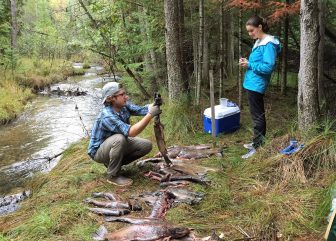
Pacific salmon often spawn in the streams in which they were hatched or stocked. Image: Brandon Gerig
By Carin Tunney
Some trout in Great Lakes tributaries are just as contaminated with a chemical linked to respiratory, liver and skin ailments as the Pacific salmon that they eat, according to biologists from the University of Notre Dame.
They said the findings should help inform decisions on eating fish, dam removal and stocking.
Pacific salmon, such as Chinook and coho, are large sports fish that live most of their lives in the Great Lakes and then spawn and die in rivers and streams, according to scientists.
New research published in the journal, Environmental Science and Technology, looked for PCBs in their tissue during autumn spawning runs in tributaries of lakes Huron, Michigan and Superior. It compared that tissue with the tissue of native brook trout and mottled sculpin that live fulltime in the same rivers and eat the eggs and flesh of the salmon.
The results showed the organic pollutant levels of the two types of fish are a close match in those living in Lake Huron and Lake Michigan tributaries. For the first time they linked the specific contamination of the salmon to that of the trout.
The research looked at some 200 forms of PCBs to create a “forensic trace,” said Gary Lamberti, a professor with the Department of Biological Sciences at Notre Dame.
“It’s like CSI for fish,” he says. “We were able to match the chemicals in salmon to those same chemicals within the brook trout.”
The contamination happens when the native river fish eat the eggs and flesh of the

Researchers from the University of Notre Dame weigh samples from Chinook salmon. Image: Brandon Gerig
migrating salmon and become exposed to PCBs — polychlorinated biphenyls — and other contaminants like mercury and chemicals found in fertilizers and flame retardants, Lamberti said. The findings should be considered by people eating fish from tributaries of the Great Lakes.
“If you are eating a brook trout from a Lake Michigan tributary with a strong run of Pacific salmon you might as well be eating the salmon itself,” he said.
“We use the expression you are what you eat.”
The findings don’t mean you should stop eating Great Lakes fish, said Titus Seilheimer, a fisheries specialist with Wisconsin Sea Grant, which monitors Great Lakes water pollution and funds research on water quality.
“This research should raise awareness about the potential sources of contamination in our fish,” said Seilheimer. “Informed anglers can make wise decisions and still enjoy Great Lakes and tributary fishes.”
There are health benefits of eating fish, Seilheimer said. People should follow waterway-specific advice for limiting servings.
Oily or fatty fish, such as salmon are high in Omega-3 fatty acids that reduce the risk of heart disease, blood clots and arrhythmias, according to the U.S. Department of Agriculture. The USDA reports that consumers can achieve the health benefits while following consumption guidelines in most cases.
Brandon Gerig, a lead researcher on the Notre Dame study, said the new study indicates a need to carefully weigh whether to remove dams and where to stock salmon.
Dam removal improves water quality, reestablishes habitats for native fish and birds and reduces the buildup of sediments.
But the risk of salmon carrying pollutants further upstream after a dam is removed must be considered, Gerig said. “We have to think really hard about what locations that we need to balance the trade off at.”
And managers should avoid stocking salmon in heavily fished streams, Gerig said. That may have a marginal impact since more than half of the salmon living in the lakes are the result of natural reproduction, according to the Wisconsin Department of Natural Resources.
Researchers and environmentalists agree that the best way to keep pollutants out of Great Lakes streams and rivers is to clean up the legacy pollution from industrial sites and prevent further contamination.
A caveat of the Notre Dame research is that similarities in conta

Although Great Lakes tributaries may look pristine, the fish within them are often contaminated. Image: Brandon Gerig
mination levels between Great Lakes and stream fish weren’t found in Lake Superior fish, Gerig said.
That may be because in Lake Superior the fish are smaller, the water is less polluted and its colder temperature creates less activity in the food web, he said.
Notre Dame researchers plan to expand the study by evaluating mercury contamination in Great Lakes fish through a partnership with the U.S. Fish and Wildlife Service.
